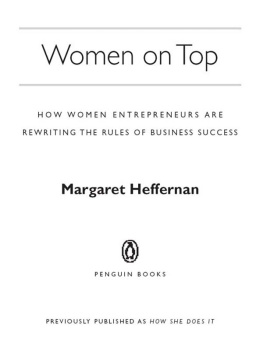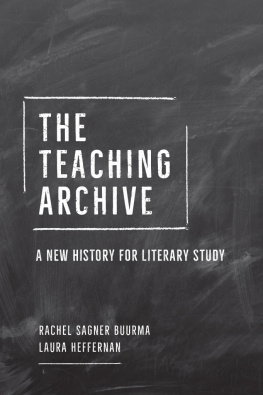Thank you for downloading this TED Books eBook.
Join our mailing list and get updates on new releases, deals, bonus content and other great books from TED Books and Simon & Schuster.
C LICK H ERE T O S IGN U P
or visit us online to sign up at
eBookNews.SimonandSchuster.com
TABLE OF CONTENTS
For Pamela Merriam Esty
I like what is in the workthe chance to find yourself.
Joseph Conrad
INTRODUCTION
We measure everything at work except what counts. Numbers are comfortingincome, expenditure, productivity, engagement, staff turnoverand create an illusion of control. But when were confronted by spectacular success or failure, everyone from the CEO to the janitor points in the same direction: the culture. Beyond measure and sometimes apparently beyond comprehension, culture has become the secret sauce of organizational life: the thing that makes the difference but for which no one has the recipe.
The paradox of organizational culture lies in the fact that, while it makes a big difference, it is comprised of small actions, habits, and choices. The accumulation of these behaviorscoming from everywhere, from the top and the bottom of the hierarchy, from inside and outside of the company itselfcreates an organizations culture. It feels chaotic and yet, at the same time, is susceptible to everything anyone does.
This represents both a curse and a blessing. For leaders, the curse lies in the sense that culture emerges of its own volitionnot just beyond measure but also beyond their control. We may not be able to measure culture but we can measure the high rate of failure for programs aiming at culture change; that stands at around 70 percent. So the idea emerges that culture is elusive, hard to manage, impossible to command.
The blessing lies in the fact that institutional cultures are nonlinear systems. Small changeslistening, asking questions, sharing informationalter beyond measure the ideas, insights, and connections those systems are capable of producing. Each of these small things generates responses that influence the system itself. And everyone, from the CEO to the janitor, makes an impact.
That insightthat great cultures depend for change on small initiatives from everyonehas been central to at least one industrys transformation. When, in 1972, a British European Airways plane crashed three minutes after take-off, killing all 118 people on board, no single leadership change could address the scale of the tragedy. What made the disaster so bitter was the recognition that the crash had been caused by problems that many people had known about earlier, concerns thathad they been articulatedmight have prevented the deaths. In the subsequent investigation, it became painfully clear that the failure to speak up, ask hard questions, or share concerns had been lethal. All the small barriers between people, functions, and geographies threatened the entire industry.
Yet from this disaster emerged a way of working togetherbuilding trust, sharing information and ideaswhich, taken together, changed the culture of civil aviation. New routines were introduced that made it easy to raise concerns, ask questions, sound the alarm or share proposals. Where there had been secrecy, now there was openness. Where mistakes had been covered up, now they were acknowledged as learning, and widely disseminated without shame or blame. Where there had been deference, now vigorous contribution was invited and gradually emerged from all sides. This new way of working was called a just culture and it transformed the least intuitive form of transport into the safest.
Today, we need just cultures across all our working environments, not just to prevent crashes but to draw from every single employee the best ideas, observations, concerns, and concepts inside every mind. We cant afford to let some thrive while others sit passively, demotivated or disenchanted. Our challenges are too big, the times too urgent, and the human capacity locked inside organizations too rich to let any of it go to waste. Just cultures tap the ingenuity, initiative, and sheer cleverness of every single individual; they reward imagination and celebrate truth-telling. They recognize that, while the road to success is littered with mistakes, it matters more to build trust and encourage ambition than to reward obedience. At the heart of any robust culture is an idea of leadership that isnt about second-guessingmarkets, shareholders, stakeholders, bosses, and peersbut having the courage to think and speak for oneself and on behalf of others.
Because organizational cultures are nonlinear systems, they cant depend on just a few lauded superstars but draw their energy from the vast collective intelligence of every employee, affiliate, partner, and customer. In that, theyre inherently democratic, demanding a generous and humble mindset. Information isnt cherished and held close to the chest because it represents power; instead it is shared and diffused for the inspiration and insight it provokes. If there is a single diagnostic indicator of a healthy workplace, it may just be the quality of connectedness and the ease of idea flow that characterizes them. In just cultures, every single person counts. As Randy Papadellis, the CEO of Ocean Spray put it, nobody wins unless everyone wins.
This sounds self-evident and it should be. But having run businesses both in the U.S. and in the U.K., I am staggered by the degree of passivity I see in companies around the world. I work with CEOs who are frustrated by the lack of energy and ingenuity they see in their workforcewhile I talk to employees who feel equally frustrated by the rules and routines that constrain their thinking and deplete their initiative. I advise leaders immobilized by their belief that they are supposed to know everythingand I see their followers silent but wishing to contribute more. Everywhere everyone complains of silos, as though the last seven years of austere efficiency have left the barriers between people stronger than their connections.
Ive lost track of the number of entrepreneurs Ive interviewed who had what turned out to be a great ideabut which they hesitated to share, for fear of seeming foolish, out of line, off strategy, too wild, too pushy, too crazy. Passivity, articulated through silence, exacts a price not just when people feel they cant warn others about problems but also when they feel they cant challenge and explore new ideas. Its in that silence that opportunitiesfor redress or innovationvanish.
In every country Ive visited, locals have insisted this challenge is uniquely theirs. In Hungary, history is held accountable for a fear of speaking up; in Singapore, the desire to save face is implicated; in Latin America pride is the culprit; the Dutch hold Calvinist modesty accountable, while the British blame traditional reserve, and Americans describe themselves as conformist. From these and many more places, Ive concluded that conflict aversion and a desire to please are universal, eviscerating our energy, initiative, and our courage.
When I talk to individuals about these wasted opportunities, they tell me the same thing: its the culture. Culture has become the alibi, the scapegoat, for everything that is wrong. But who can fix it? Only everyone. Thats why this book is aimed at everyone and anyonefrom the CEO to the janitorwho wants a better place to work. It looks at the accumulation of small, everyday thoughts and habits that generate and sustain culture: ways of speaking, listening, arguing, thinking, seeing. These arent multimillion dollar, multi-year programs; these are small steps that anyone can take at any time, the small steps that mark the beginning of big change.
Next page








